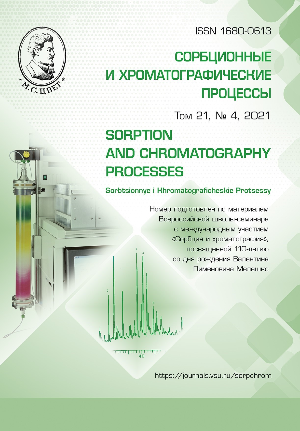The kinetics and mechanism of sulphate ion adsorption on KM-2 activated carbon
Abstract
The article is devoted to the study of the kinetics of adsorption and electrosorption (adsorption under cathodic potential) of SO42- ions on KM-2 activated carbon. The study was carried out in a batch mode. The experimental data regarding the kinetics of the SO42- adsorption on nonpolarised and polarised carbon were processed using kinetic diagrams for mixed diffusion and a linear isotherm. The comparison of the experimental data with theoretical dependences showed that the equation of mixed diffusion kinetics close to external diffusion better describes the adsorption of sulphate on a nonpolarised carbon than the electrosorption of these ions.
It was found that cathodic polarisation increases the sorption of these ions. In addition, during electrosorption under the conditions of cathodic polarisation, a significant part of SO42- ions are absorbed irreversibly and the excess part of the adsorptive is not desorbed when the polarisation changes. The studies showed that the adsorption processes of the SO42- ions on nonpolarised and cathode-polarised KM-2 carbon can be satisfactorily described by models of formal kinetics which allows for the possibility to chemically limit the rate of such processes. Based on the fact that the adsorption of the studied ions was irreversible, it was concluded that the chemical mechanism of deceleration influences the kinetics of the process of sulphate electrosorption on KM-2 activated carbon under the conditions of cathodic polarisation.
A semiempirical PM3 method and the Orca 4.2 software were used for a quantum chemical study of the adsorption process of a sulphate ion on the surface of activated carbon simulated by an oxygen-containing carbon cluster C98O5H3. It was shown that SO42- ions are strongly adsorbed directly on the surface of activated carbon.
Downloads
References
Benatti C.T., Tavares C.R.G., Lenzi E., J. Environ. Manag., 2009, Vol. 90, pp. 504-511.
Tait S., Clarkeb W.P., Keller J., Bat-stonea D.J., Water Research, 2009, Vol. 43, pp. 762-772.
Basha C.A., Selvi S.J.,Ramasamy E., Chellammal S., Chem. Eng. J., 2008, Vol. 141, pp. 89-98.
Lee H.J., Oh S.J., Moon S.H., Wat. Res., 2003, Vol. 37, pp. 1091-1099.
Galliana-Aleixandre M.V., Iborra-Clar A., Bes-Pifi A. et al., Desalination, 2005, Vol. 179, pp. 307-313.
Bodalo A., Gomez J.L. Gomez E., Leon G., Tejera M., Desalination, 2004, Vol. 162, pp. 55-60.
Boukhalfa C., Desalination, 2010, Vol. 250, pp. 428-432.
Kolics A., Polkinghorne J.C., Wieckow-ski A., Electrochimica Acta, 1998, Vol. 43, pp. 2605-2618.
Ljng R., Liu Y., Wang X., Huang J., J. Chem. Eng. Data, 2011, Vol. 56, pp. 3890-3896.
Rahmati, Yeganeh G., Esmaeili H., Acta chim. Slov., 2019, Vol. 66, pp. 886-898.
Salman M.S., Al-Khwarizmi Eng. J., 2009, Vol. 5, pp. 72-76.
Mahmudov R., Huang Ch.P., Sep. Pur. Technol., 2011, Vol. 77, pp. 294-300.
Ota K., Amano Y., Aikawa M., Appl. Sur. Sci., 2013, Vol. 276, pp. 838-842.
Yusupova (Ramazanova) A.A., Svesh-nikova D.A., Ramazanov A Sh., Vestnik DGU. Estestvenniye nauki, 2006, No 1, pp. 38-44.
Sveshnikova D.A., Gafurov M.M., Shabanova Z.E., Asvarov A.Sh. et al., Izv. vysshikh utshebnykh zavedenii. Khimiya and Khimitsheskaya tekhnologiya, 2009, Vol. 52, pp. 38-41.
Sveshnikova D.A., Ramazanov A.Sh., Gafurov M.M., Kunzhueva K.G. et al., Sorbtsionnye i khromatograficheskie protsessy, 2012, Vol. 12, No 5, pp. 789-796.
Sveshnikova D.A., Gafurov M.M., Ataev M.B. Rabadanov K.Sh. et al., Chemis-try, Phyzik and Surface Technology, 2013, Vol. 4, No 1, pp. 27-36.
Sveshnikova D.A., Abakarov A.N., Dribinski A.V., Gafurov M.M. et al., Rus. J. Phys. Chem., 1993, Vol. 67, No 7, pp. 1439-1443.
Reznikov A.A., Mulikovskaya E.P., Sokolov Yu., Metody analiza prirodnykh vod, M., Gos.nauchno-tekh. izd-vo literatury po geologii i okhrane nedr, 1963, 404 s.
Rudzinski W., Plazinski W., Appl. Surf. Sci., 2007, Vol. 253, pp. 5827-5840.
Rudzinski W., Plazinski W., J. Phys. Chem. C, 2007, Vol. 111, pp. 15100-15110.
Plazinski W., Dziuba J., Rudzinski W., Adsorption, 2013, Vol. 19, pp. 1055-1064.
Azizian S., J. Colloid Interface Sci, 2004, Vol. 276, pp. 47-52.
Khamizov R.Kh., Sveshnikova D.A.,Kutsherova A.E., Sinyaeva L.A., Rus. J. Phys. Chem.. 2018, Vol. 92, pp.1451-1460. DOI: 10.1134/S0044453718090121
Khamizov R.Kh., Rus. J. Phys. Chem., 2020, Vol. 94, pp. 125-130. DOI:10.31857/S0044453720010148
Venitsianov E.V., Rubinshtein R.N., Dinamika sorbtsii iz zhidkikh sred, M., Nau-ka Publ, 1983, 237 p.
Nikashina V.A., Sorbtsionnye i khromatograficheskie protsessy, 2008, Vol. 8, pp. 227-240.
Lagergren S., Kungliga Svenska Vetenkapsakademiens. Handlingar, 1898, Vol. 24, pp. 1-39.
Ho Y.S., McKay G., Process. Biochem., 1999, Vol. 34, pp. 451-465.
Boehm H.P. Chemical Identification of Surface groups. In: Advances in catalysis and related subjects. 1966, Vol. 16, pp.179-274.
Runtti H., Tuomikoski S., Kangas T. et al., BioResources, 2016, Vol. 11, pp. 3136-3152.
Walter T., WIREs Comput. Mol. Sci., 2014, Vol. 4, pp. 145-157.
Dral P.O., Wu X., Thiel W., J. Chem. Theory Comput., 2019, Vol. 15, pp. 1743-1760.
Solov’ev M.E., Solov’ev M.M., Kom-puternaya khimiya, M., SOLON-Press Publ, 2005, 536 p.
Khamizov R.Kh., Sveshnikova D.A., Kutsherova A.E., Sinyaeva L.A., Rus. J. Phys. Chem., 2018, Vol. 92, pp. 1619-1625. DOI: 10.1134/S0044453718100114







